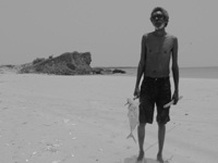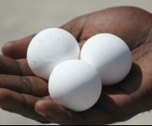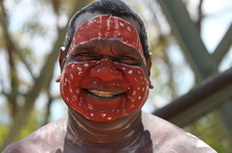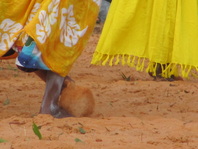Yolŋu culture

All Yolŋu people in north eastern Arnhem Land belong to one of two basic divisions, or moieties, called Dhuwa and Yirritja. Children belong to the same moiety as their father; their mother belongs to the other moiety.
Everything in the Yolŋu universe – Spirit Beings, plant and animal species, clan groups, areas of land and water are either Dhuwa or Yirritja. The Djang'kawu Sisters, the morning star, the water goanna, the stringybark tree, and the land in and around Yirrkala are Dhuwa, while such things as the evening star, stingray, cycad palm, and members of the Mangalili clan are all Yirritja.
Within each moiety, people belong to smaller groups called clans, each having its own language. Children belong to their father’s clan (and moiety), while their mother belongs to another clan (of the other moiety). In the Gove Penninsula and the surrounding area, most Yolŋu belong to one of sixteen clans, of which eight are Dhuwa and eight are Yirritja.
Clan members own areas of land and waters in common. The relationship is, however, much more complex than just ‘owning’, or even ‘caring for’, the land. Yolŋu often say that they ‘come from’ the land, or that they ‘are the land’ – a difficult concept for non-Aboriginal people to grasp. How can it be explained?
The land and waters of each clan were bestowed on the forebears of living clan members long ago in Wangarr Time, which Yolŋu may refer to in English as ‘Creation Time’; or sometimes they just say long ago. Some follow the common Australian English practice of using the terms ‘Dreamtime’ or ‘Dreaming’.
One person explained it as ‘sacred time shining, long time ago’. A clan’s land and waters were bestowed on it by one or a particular set of the many sacred and powerful Wangarr Beings who travelled across the landscape during this time of creation.
‘Spirit man’, or ‘Spirit woman’, ‘ancestor’, ‘totem’, or various combinations of these, are some of the English terms used by both Yolngu and non-Yolngu speakers attempting to explain the complex concept of Wangarr.
Everything in the Yolŋu universe – Spirit Beings, plant and animal species, clan groups, areas of land and water are either Dhuwa or Yirritja. The Djang'kawu Sisters, the morning star, the water goanna, the stringybark tree, and the land in and around Yirrkala are Dhuwa, while such things as the evening star, stingray, cycad palm, and members of the Mangalili clan are all Yirritja.
Within each moiety, people belong to smaller groups called clans, each having its own language. Children belong to their father’s clan (and moiety), while their mother belongs to another clan (of the other moiety). In the Gove Penninsula and the surrounding area, most Yolŋu belong to one of sixteen clans, of which eight are Dhuwa and eight are Yirritja.
Clan members own areas of land and waters in common. The relationship is, however, much more complex than just ‘owning’, or even ‘caring for’, the land. Yolŋu often say that they ‘come from’ the land, or that they ‘are the land’ – a difficult concept for non-Aboriginal people to grasp. How can it be explained?
The land and waters of each clan were bestowed on the forebears of living clan members long ago in Wangarr Time, which Yolŋu may refer to in English as ‘Creation Time’; or sometimes they just say long ago. Some follow the common Australian English practice of using the terms ‘Dreamtime’ or ‘Dreaming’.
One person explained it as ‘sacred time shining, long time ago’. A clan’s land and waters were bestowed on it by one or a particular set of the many sacred and powerful Wangarr Beings who travelled across the landscape during this time of creation.
‘Spirit man’, or ‘Spirit woman’, ‘ancestor’, ‘totem’, or various combinations of these, are some of the English terms used by both Yolngu and non-Yolngu speakers attempting to explain the complex concept of Wangarr.

The Wangarr beings hunted animals, gathered a variety of vegetable foods, held ceremonies and generally behaved in the same way as Yolŋu people did at the time of the establishment of a mission at Yirrkala in 1935. There were important differences, however.
For one thing, the Wangarr created through their activities the present features of the landscape and seascape such as rivers, rocks, sandhills, trees and islands, and left the land and waters imbued with their spiritual essence.
They also ‘sang’ the names of everything they created or interacted with, making certain species sacred to the clan on whose land or in whose waters the naming took place.
Additionally, although the Wangarr were manifested in human form during their creative travels and activities, many, though not all, are also considered to have had the attributes of a particular species, such as crocodile or shark.
Eventually, the Wangarr was transformed into that species. Subsequently, this species became a major ‘totem’ of the clan associated with the site of such events. Indeed, members of that clan may think of themselves as being, for example, water goanna, while another clan’s members may think of themselves as being shark.
As well as the landscape they had created, the Wangarr also left behind for the clan sacred objects, designs and names that were manifestations of themselves, imbued like the land and water with their spiritual essence and power.
For one thing, the Wangarr created through their activities the present features of the landscape and seascape such as rivers, rocks, sandhills, trees and islands, and left the land and waters imbued with their spiritual essence.
They also ‘sang’ the names of everything they created or interacted with, making certain species sacred to the clan on whose land or in whose waters the naming took place.
Additionally, although the Wangarr were manifested in human form during their creative travels and activities, many, though not all, are also considered to have had the attributes of a particular species, such as crocodile or shark.
Eventually, the Wangarr was transformed into that species. Subsequently, this species became a major ‘totem’ of the clan associated with the site of such events. Indeed, members of that clan may think of themselves as being, for example, water goanna, while another clan’s members may think of themselves as being shark.
As well as the landscape they had created, the Wangarr also left behind for the clan sacred objects, designs and names that were manifestations of themselves, imbued like the land and water with their spiritual essence and power.

They passed on, too, to the founding members of each clan their language, law, paintings, songs, dances, ceremonies and creation stories, all emanating from the Wangarr presence and activities in clan land and waters. Together, the land and waters and this sacred clan property, both tangible and intangible, form a clan member’s djalkiri, his or her ‘foundation’, as Yolŋu translate this important concept.
The Yolŋu word for land (or place or camp) is ngirrima. In everyday speech, djalkiri may be used in its literal sense of ‘foot’ or ‘footprint’.
In its metaphorical sense it represents the ‘footprints’ of the Wangarr as they travelled across the clan’s land and waters, all the signs and traces they left in their tracks: the evidence of their presence and land-shaping activities and transformations in the land itself and in the sacred designs, paintings, songs and ceremonial objects. It is the djalkiri, this foundation, that provides each individual with meaning and identity.
Yolŋu individuals belong as much to the djalkiri as it does to them. Spiritually they are part of it. Within every clan’s land and waters there are one or more areas where ‘spirit children’, formed of the Wangarr essence, await their time to be born into the world of the living. When that time comes, a ‘spirit child’ enters its mother’s womb to animate the foetus.
During life, people may continue to absorb Wangarr power through ritual contact with other manifestations of the Wangarr; for example, through sacred clan designs painted ceremonially on the body. After death, the individual’s spirit returns, with ritual help, to his or her clan land.
There it becomes one again with the spirits of the dead and the Wangarr essence, to be drawn upon by future generations of spirit children and clan members.
The Yolŋu word for land (or place or camp) is ngirrima. In everyday speech, djalkiri may be used in its literal sense of ‘foot’ or ‘footprint’.
In its metaphorical sense it represents the ‘footprints’ of the Wangarr as they travelled across the clan’s land and waters, all the signs and traces they left in their tracks: the evidence of their presence and land-shaping activities and transformations in the land itself and in the sacred designs, paintings, songs and ceremonial objects. It is the djalkiri, this foundation, that provides each individual with meaning and identity.
Yolŋu individuals belong as much to the djalkiri as it does to them. Spiritually they are part of it. Within every clan’s land and waters there are one or more areas where ‘spirit children’, formed of the Wangarr essence, await their time to be born into the world of the living. When that time comes, a ‘spirit child’ enters its mother’s womb to animate the foetus.
During life, people may continue to absorb Wangarr power through ritual contact with other manifestations of the Wangarr; for example, through sacred clan designs painted ceremonially on the body. After death, the individual’s spirit returns, with ritual help, to his or her clan land.
There it becomes one again with the spirits of the dead and the Wangarr essence, to be drawn upon by future generations of spirit children and clan members.

The phrase djalkiri wanga applies to a particularly important and sacred area of a clan’s land or waters that is associated with crucial Wangarr events and spirituality. This is the home or homeland from which clan spirits emanate and to which they return. It is this land and these waters which form the basis of an individual’s djalkiri and that provide the solid foundation on which his or her identity is built.
Yolŋu relationship to the land and waters does not end here, however. Just as individuals can think of themselves as being a totemic species or say that they are the land, so too can their nandi (mothers), and mari (grandmothers), and other kin.
An individual, therefore, calls his or her mother’s Wangarr species nandi and refers to her country as nandi wanga; in the case of a grandmother’s Wangarr and wanga the kin term mari is used, and so on. The extreme importance of the widespread network of kinship in Yolŋu society means that most people would know their relationship to a wide number of places in terms of their relationship to the people who own them.
Yolŋu relationship to the land and waters does not end here, however. Just as individuals can think of themselves as being a totemic species or say that they are the land, so too can their nandi (mothers), and mari (grandmothers), and other kin.
An individual, therefore, calls his or her mother’s Wangarr species nandi and refers to her country as nandi wanga; in the case of a grandmother’s Wangarr and wanga the kin term mari is used, and so on. The extreme importance of the widespread network of kinship in Yolŋu society means that most people would know their relationship to a wide number of places in terms of their relationship to the people who own them.
This is an excerpt from Dhimurru's Visitor Guide. This section, slightly amended, is taken from: ‘Djalkiri Wanga; the Land is My Foundation; 50 Years of Aboriginal Art from Yirrkala, Northeast Arnhem Land’, by Gillian Hutcherson, (Berndt Museum of Anthropology Occasional Paper No. 4), The University of Western Australia, 1995, with permission from and thanks to the author.
